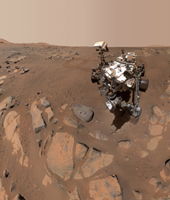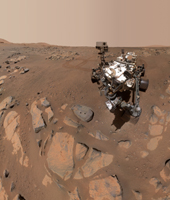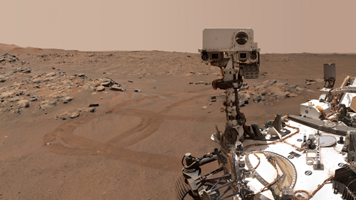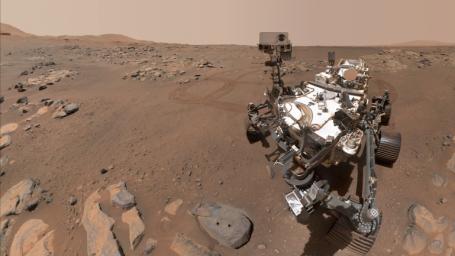
Figure 1

Figure 2

Figure 3
Click on images for larger versions
Click here for animation
NASA's Perseverance Mars rover took this selfie over a rock nicknamed "Rochette," on September 10, 2021, the 198th Martian day, or sol of the mission. Two holes can be seen where the rover used its robotic arm to drill rock core samples. There are two versions of the selfie: Figure 1 shows Perseverance looking at the rock holes and Figure 2 shows it looking back at the camera. Each version is made up of 57 individual images that are sent back down to Earth and stitched into the resulting selfies. Figure 3 is a cropped close-up of Figure 2.
Perseverance uses a camera called WATSON (Wide Angle Topographic Sensor for Operations and eNgineering) on the end of its seven-foot-long (two-meter-long) robotic arm to take its selfies. A detailed explanation of how it takes the selfies is available here.
NASA's Jet Propulsion Laboratory built and manages operations of Perseverance and Ingenuity for the agency. Caltech in Pasadena, California, manages JPL for NASA. WATSON was built by Malin Space Science Systems (MSSS) in San Diego and is operated jointly by MSSS and JPL.
A key objective for Perseverance's mission on Mars is astrobiology, including the search for signs of ancient microbial life. The rover will characterize the planet's geology and past climate, pave the way for human exploration of the Red Planet, and be the first mission to collect and cache Martian rock and regolith (broken rock and dust).
Subsequent NASA missions, in cooperation with ESA (European Space Agency), would send spacecraft to Mars to collect these sealed samples from the surface and return them to Earth for in-depth analysis.
The Mars 2020 Perseverance mission is part of NASA's Moon to Mars exploration approach, which includes Artemis missions to the Moon that will help prepare for human exploration of the Red Planet.
JPL, which is managed for NASA by Caltech in Pasadena, California, built and manages operations of the Perseverance rover.
For more about Perseverance:
mars.nasa.gov/mars2020/
nasa.gov/perseverance

 Planetary Data System
Planetary Data System















